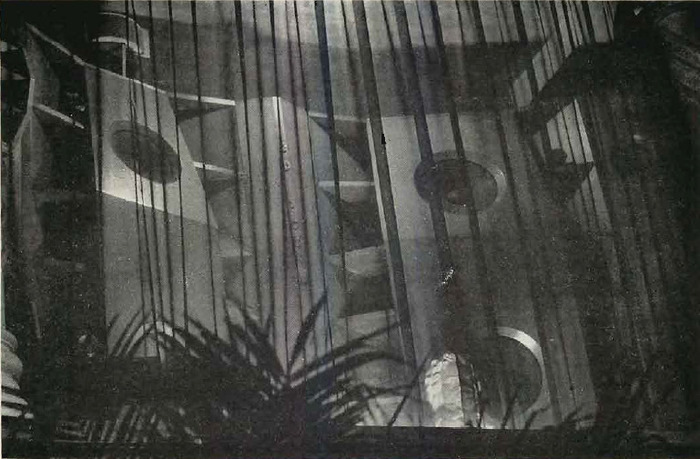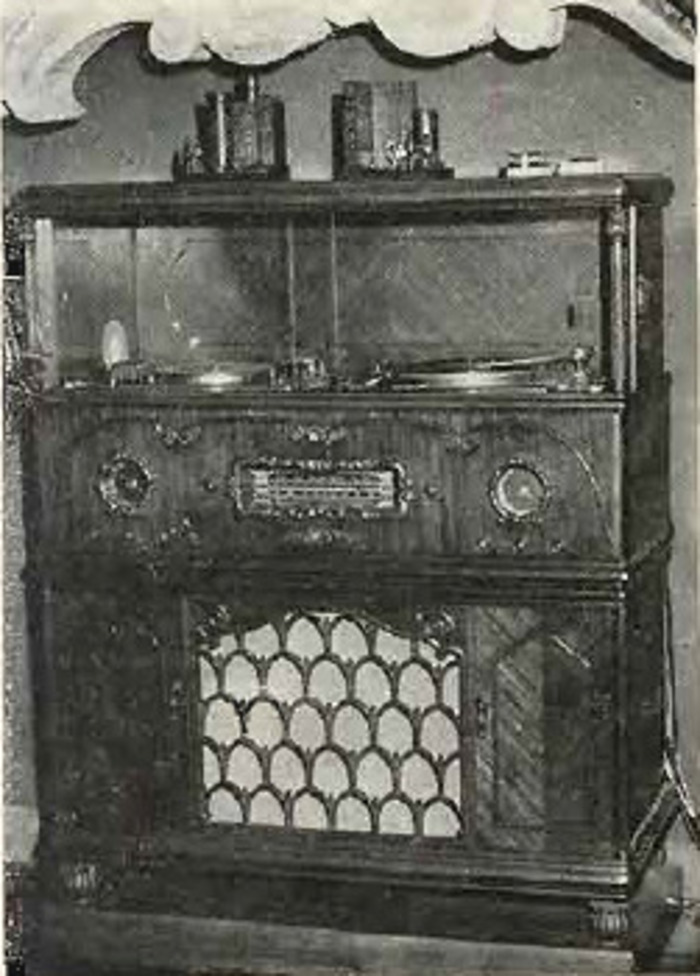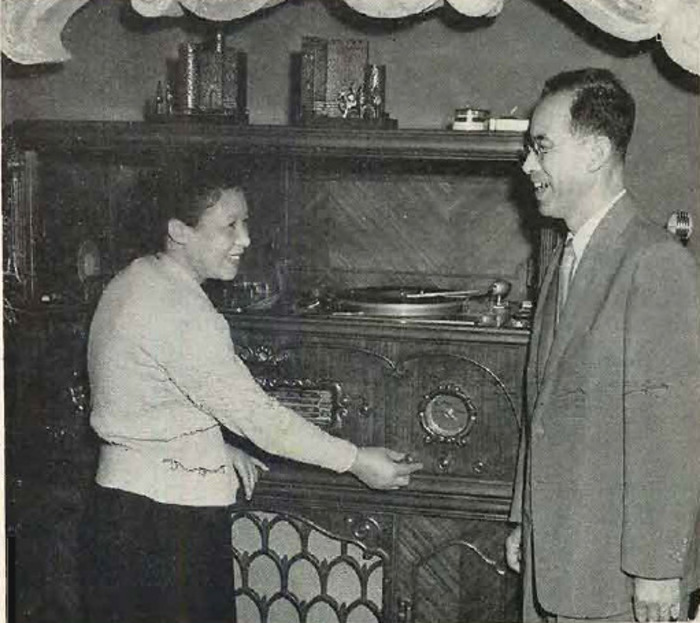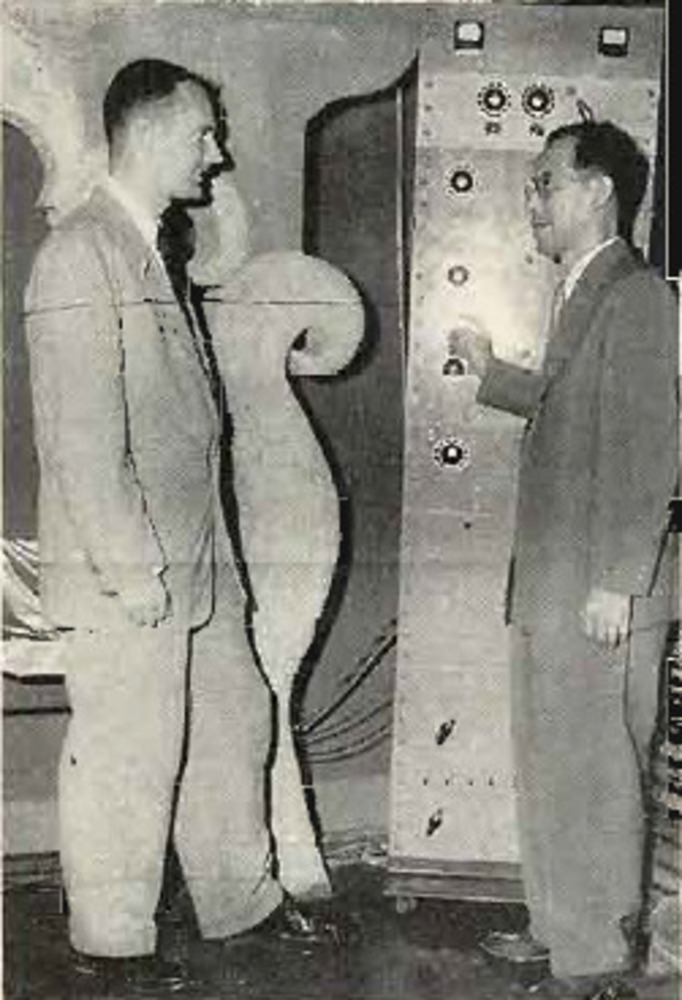Lion in Audio Magazine
Lion is a cafe in the Hyakkendana neighborhood of Dougenzaka in Shibuya. Opened in 1926, they play classical music and twice a month print a program with their schedule. The back of the program says:
We are proud to note that, with the publication of an article in the American magazine "Audio" featuring our sound system, including photographs, Shibuya's Lion has become a world-class Lion.
The article in question is from the 1958 December issue of Audio Magazine. Given the date and the apparent lack of copyright renewal the article is probably in the public domain. This copy was sourced from the Audio Magazine Archive generously provided by AmericanRadioHistory.com.
In the first part of the article there's a passing reference to a five-story cafe with an elevator stage. I haven't been able to find any other reference to this in Japanese or English, but if you have any idea what place is indicated please be in touch.

Can you count the speakers in this array? A Japanese stereophonic speaker system, it includes two eighteen-inch woofers, two fifteen-inch woofers, two eight-inch mid-range cones, and an assortment of other units to cover the entire audio spectrum.
Hi-Fi with that Coffee Aroma
And why not couple the enjoyment of good coffee with an equally pleasant enjoyment of good music? The author suggests this might be an excellent method of attracting potential customers to the hi-fi salon - or maybe carrying it further and using two "o's" would be still more effective.
by Ed. Snape
In the early seventeen hundreds, coffee shop culture came into its own in Queen Anne's London. The world's largest city boasted coffee shops catering to wide social, political, literary, and business interests. Coffee-culture fathered those great periodicals, The Tatler and The Spectator. Lloyd's Insurance evolved from a coffee shop for exchange of shipping news. The art of conversation is said to have reached an all-time high in those London meeting places.
In the mid-twentieth century, a new coffee shop culture is growing up in the what is now the world's largest city, Tokyo. There more than a thousand coffee shops attract millions of patrons to their friendly and relaxed atmospheres. The art of conversation is still practiced, but in lower tones than in London coffee shop days. High-fidelity music is now the main attraction.
The largest coffee shops, seating hundreds of patrons, feature the highest kind of fidelity - live musicians. In one plush, five-story edifice the musicians play quite unconcernedly while riding an elevator stage from floor to floor. Since this moving stage can only be on one floor at a time, a high fidelity amplification system relays the musician's performance to other floors during the interim. In another downtown Tokyo shop the orchestra is suspended on a tiny balcony over illuminated fountains and fishponds, surrounded by tiers of circular balconies rising five floors toward a gigantic chandelier and mosaic ceiling. In a less exotic atmosphere, members of the JKR radio orchestra perform nightly in a Shinjuku coffee sohp, from which regular hi-fi broadcasts are originated.
The Smaller Shops
For practical reasons, live music cannot be feature in more than a handful of coffee houses, and more than nin hundred remaining coffee shops offer recorded high fidelity performances for the their musical offerings. These are a natural haven for stereofans and audiofans as well as music and coffee lovers. In the majority, the equipment is good but simple. REcord changers are almost unheard of in Japan. Most coffee shops use a pair of the excellent Japanese viscous-damped pickup arms, magnetic cartridges, and well-made transcription turntables. The long-playing records are relatively expensive to the Japanese and are most meticulously cared for by their owners. Record attendents in Tokyo coffee shops are paragons when it comes to preserving the delicate micro-grooves which earn their livelihood.
With so many different coffee houses seeking his patronage, the Tokyoite may choose music in just about any vein imaginable. The majority of shops play "music-between" and light classics. A few have built reputations by specializing in French, Italian, or Spanish music - all quite popular with the Japanese. Some coffee shops cater to Japanese teenagers by presenting U.S. rock-and-roll and hillbilly "cultural" offerings, occasionally interspersed with good jazz, but the best coffee houses offer a solid repertoire of serious classical music.
With record collections running to the thousands, many of the shops feature a continuous classical request program. Their patrons seem to have a wide knowledge and appreciation of serious music.
Other shops, however, hold to carefully selected and balanced program schedules. The schedules are published in program guides similar to those issued by our leading good-music broadcast stations.
A Typical Visit
Join me, if you will, for a visit to one of such refined coffee house in the Shibuya area of Tokyo. The "New Lion Coffee House" is on a small lane away from the main thoroughfares of Shibuya. This is an amusement district and the lane is lined on both sides with theatres, restaurants, cabarets, pachinko parlors, and not a few good coffee shops. A rock-and-roll record is blasting across the way, (Are rock-and-roll-records ever played otherwise, anywhere in the world?) but here is the "New Lion" on our right. As we open the door and step inside, we step into another world. The din of taxi horns, street cars, and Elvis Presley is left outside. Instead, there is the solid but restrained sound of a symphony orchestra in the next room. An attractive young lady bows graciously and greets us. Do we prefer the balcony or the main hall? The balcony is not crowded today, so our hostess beckons us toward a small flight of stairs. At the top, we step out into a miniature concert hall. Soaring music surrounds us. The lights are dimmed; the audience is hushed. We are guided quickly and quietly to our table hwere we are handed a menu and a program guide. Alas, we cannot read Japanese; but coffee is coffee and the music is undeniably Mozart. In fact, it is a sterophonic tape recording of the Jupiter symphony. Here is stereo as it never quite sounded in the audio showroom back home. Perhaps this concert hall atmosphere does much to enhance the realism of the recorded performance, at any rate we are soon absorbed in the concluding movement of the symphony.
The audience does not applaud at the conclusion, most of the people engage in quiet conversation. We will take advantage of this short intermission to get a better look at the audio system. The speaker system is most fascinating and after several trys we succeed in counting all the various drivers and horns. There are two 18-in. woofers, two 15-in. woofers, two 8-in. mid-range cones, three electrostatics, and a full-complement of mid-range and tweeter horns. The woofers are horn-loaded in extraordinarily solid-looking folded theatre horns.
The remainder of this deluxe hi-fi system is housed in a rack and cabinet in an alcove beneath the speaker stage. Behind sliding glass panels in the cabinet are the two transcription turntables equipped with capacitor pickups. One turntable has two of the pickups mounted side by side to play Cook binaural disks. Dual AM tuners are provided for reception of weekly stereo broadcassts by the two government AM radio channels. An all-wave receiver and equalizer controls are also housed in the cabinet.

Records spin on high-quality transcription turntables in a glass-enclosed cabinet, which also houses an all-wave tuner and dual AM tuners. The latter pick up weekly stereo broadcasts by two Japanese government AM stations.
Power amplifiers and power supplies are rack mounted in a full-height standard relay rack. There are four separate power amplifiers, electronic cross-overs, and individual level set controls. A professional looking stereo tape player occupies a position adjacent to the rack. Lining one side wall are shelves holding a collection of disks and tapes that would arouse the envy of any self-respecting radio station.

Tuning in a stereo broadcast. The record playing equipment consists of two transcription turntables with capacitor pickups.
The attendant announces each selection and displays its album cover for the audience. Patrons are welcome to stay and enjoy the music as long as they like; with no compulsion to buy more coffee. We find the hi-fi music-coffee combination a delightful one though, and order several times during the recorded concert. Therein lies the economic soundness of good sound.
A few hours spent in one of Tokyo's better coffee shops are enough to convince one that good coffee, pleasing and imaginative decor, and high-fidelity music are an extraordinarily good combination. The coffee shops create among their patrons a desire to own their own recordings and equipment. The offer a superior standard of audio reproduction for the active audiofan to aspire to. Most important of all, they offer the man in the street an opportunity to enjoy full-length musical performances by the world's best musicians, reproduced on top flight equipment in an atmosphere conducive to listening.

Coffe-shop manager displays his amplifier equipment mounted in a professional relay rack.
In the author's opinion, the coffee shops of Japan do a far superior job of championing high fidelity and stereo than do most radio parts houses and audio showrooms; here or abroad. An enjoyable full-length musical performance presented in a relaxing atmosphere seems far more apt to sell audio equipment or records than is a raucous demonstration in the hustle and bustle of a typical showroom. It is suggested that a coffee shop would make a profitable adjunct to a high fidelity store. A well-managed coffee shop could earn profits on its food and beverage sales and at the same time serve as the finest kind of advertisment for its parent organization. The shop would allow music lovers and audiofans to sharpen their ears to the superior performance of high-grade equipment, thereby easing the job of selling and educating in the actual store next door.
Hi-fi coffee shops here in the United States would bring many of us an inexpensive respire of pleasure and relaxation to the tune of good music, faithfully reproduced, in pleasant surroundings. Ψ